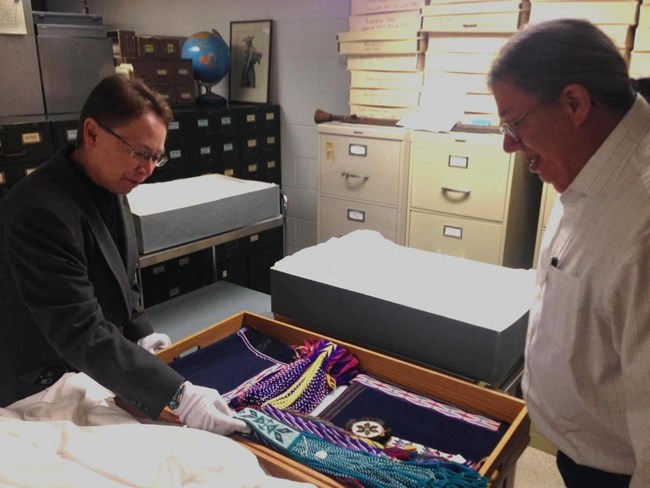
Courtesy of The Osage Nation.
Museums and Federal agencies must give public notice prior to disposition or repatriation of human remains or cultural items to lineal descendants, Indian Tribes, or Native Hawaiian organizations. After a notice is published, and in order to complete the disposition or repatriation, museums and Federal agencies must send written statements to the claimants or requestors. The type of notice and statement required depends on the human remains or cultural items involved.
What notices and statements are required?
For protection of human remains and cultural items on Federal or Tribal lands:
A Notice of Intended Disposition identifies the lineal descendant, Indian Tribe, or Native Hawaiian organization with priority for disposition, and
A Disposition Statement recognizes the claimant(s) has ownership or control of the human remains or cultural items.
For repatriation of human remains and associated funerary objects:
A Notice of Inventory Completion identifies if cultural affiliation of human remains and associated funerary objects has been determined, and
A Repatriation Statement relinquishes possession or control of the human remians or associated funerary objects to the requestor(s).
For repatriation of unassociated funerary objects, sacred objects, or objects of cultural patrimony:
A Notice of Intended Repatriation identifies that a request for repatriation has received and accepted, and
A Repatriation Statement relinquishes possession or control of the unassociated funerary objects, sacred objects, or objects of cultural patrimony to the requestor(s).
What must be done to publish a notice?
Museums, Federal agencies, and DHHL must submit notices to the National NAGPRA Program for publication in the Federal Register. The notice must conform to the mandatory format of the Federal Register and include required information. Notice templates are available for each kind of notice.
For all notices submitted to the National NAGPRA Program, no later than 21 days after receiving a notice, the Manager, National NAGPRA Program, must:
- Approve for publication in the Federal Register any submission that conforms to the mandatory format and requirements, or
- Return to the museum, Federal agency, or DHHL any submission that does not conform to the mandatory format or requirements. No later than 14 days after the submission is returned, the museum, Federal agency, or DHHL must resubmit the notice to the National NAGPRA Program.
What if something changes after publication of a notice?
After publication of a notice, if additional human remains or cultural items are identified that were not previously included in an inventory, summary, or notice of any kind, the museum, Federal agency, or DHHL must begin with Step 1 in each of the processes for the newly identified human remains or cultural items. This will ensure adequate consultation and notification occurs prior to disposition or repatriation. Additional pieces or fragments of previously identified human remains or cultural items are not newly identified human remains or cultural items and can be transferred to the appropriate lineal descendant, Indian Tribe or Native Hawaiian organization without publication of a new notice.
An OPTIONAL amendment notice may be published if requested by the consulting parties. An amendment notice may ADD or REVISE the lineal descendants or Indian Tribes and Native Hawaiian organizations with cultural affiliation listed in a previously published notice. Notice templates are available for each kind of notice.
Where are disposition or repatriation statements sent and then what happens?
Dispostion or repatriation statements must be sent to the claimants or requestors and a copy to the National NAGPRA Program. In the case of joint claims for disposition or request for repatriation, the statement must identify and be sent to all claimants or requestors.
After disposition or repatriation statements are sent to claimants or requestors, the museum or Federal agency must:
- Consult on custody and physical transfer,
- Document any physical transfer, and
- Protect sensitive information, as identified by the claimant or requestor, from disclosure to the general public to the extent consistent with applicable law.
Last updated: April 18, 2025
